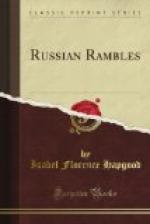As a parallel case, I may add that there were plenty of intelligent people in New York city and elsewhere who were not aware that the United States still issued three-cent stamps, or who could tell the color of them, until the Columbian set appeared to attract their attention.
II.
THE NEVSKY PROSPEKT.
The Nevsky Prospekt!
From the time when, as children, we first encounter the words, in geographical compilations disguised as books of travel, what visions do they not summon up! Visions of the realm of the Frost King and of his Regent, the White Tzar, as fantastic as any of those narrated of tropic climes by Scheherezade, and with which we are far more familiar than we are with the history of our native land.
When we attain to the reality of our visions, in point of locality at least, we find a definite starting-point ready to our hand, where veracious legend and more veracious history are satisfactorily blended. It is at the eastern extremity of the famous broad avenue,—which is the meaning of Prospekt. Here, on the bank of the Neva, tradition alleges that Alexander, Prince of Novgorod, won his great battle—and, incidentally, his surname of Nevsky and his post of patron saint of Russia—over the united forces of the Swedes and oppressive Knights of the Teutonic Order, in the year 1240.
Nearly five hundred years later, the spot was occupied by Rhitiowa, one of the forty Finnish villages scattered over the present site of St. Petersburg, as designated by the maps of the Swedes, whom Peter the Great—practically Russia’s second patron saint—expelled anew when he captured their thriving commercial town, on the shore of the Neva, directly opposite, now known as Malaya Okhta, possessed of extensive foreign trade, and of a church older than the capital, which recently celebrated its two-hundredth anniversary.
It was in 1710 that Peter I. named the place “Victory,” in honor of Prince-Saint Alexander Nevsky’s conquest, and commanded the erection of a Lavra, or first-class monastery, the seat of a Metropolitan and of a theological seminary. By 1716 the monastery was completed, in wood, as engravings of that day show us, but in a very different form from the complex of stone buildings of the present day. Its principal facade, with extensive, stiffly arranged gardens, faced upon the river,—the only means of communication in that town, planted on a bog, threaded with marshy streams, being by boat. In fact, for a long time horses were so scarce in the infant capital, where reindeer were used in sledges even as late as the end of the last century, that no one was permitted to come to Court, during Peter the Great’s reign, otherwise than by water. Necessity and the enforced cultivation of aquatic habits in his inland subjects, which the enterprising Emperor had so much at heart, combined to counsel this regulation.




